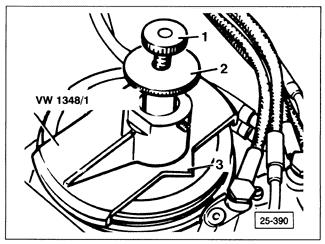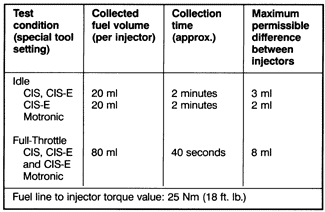Testing Injector Fuel DeliveryA similar test is used to precisely measure and compare fuel delivery from the four injectors as a means of isolating a bad injector or a faulty fuel distributor. Connect the four injectors to four identical measuring containers as shown in Fig. 4-30.

Connect a remote switch or a fused jumper wire to bypass the fuel pump relay and run the fuel pump, as described in 4.1 Fuses and Relays. Volkswagen special tool no. VW 1348/1 (order no. TV1 348 001 25 ZEL), is used to raise and hold the sensor plate in the various test positions. Install the special tool as shown in Fig. 4-31. Carefully push the center sleeve all the way down, then turn the adjusting knob clockwise until the tool's magnetic tip just contacts the sensor plate bolt. Slowly turn the adjusting screw counterclockwise to raise the sensor plate, adjusting it to a point just before the injectors start to discharge fuel. Then stop the fuel pump and, if necessary, empty the measuring containers.

The purpose of this test is to compare injector fuel flow rates. The tool's center sleeve has two detents-one raises the plate to a position simulating idle; the second raises it higher to simulate full throttle. At the idle setting, run the pump to collect a fuel sample, then switch off the pump and compare the containers. Empty the measuring containers and repeat the test above at the full throttle setting. Test specifications are given in Table e. Table e. Injector Fuel Delivery Test Specifications
If the difference between any two injectors is excessive, pick out the two injectors with the lowest and highest values. Loosen the unions, remove the injectors from their fuel lines, exchange them, and repeat the test. If the same injector delivers a low amount of fuel, it is faulty and should be replaced. If the same container collects a low amount from a different injector, then that fuel line is blocked or kinked, or the fuel distributor is faulty. |
